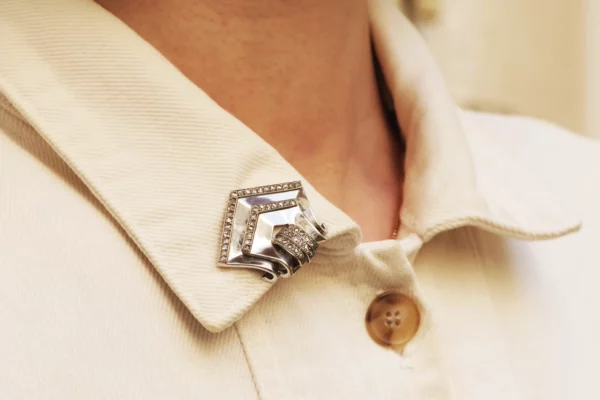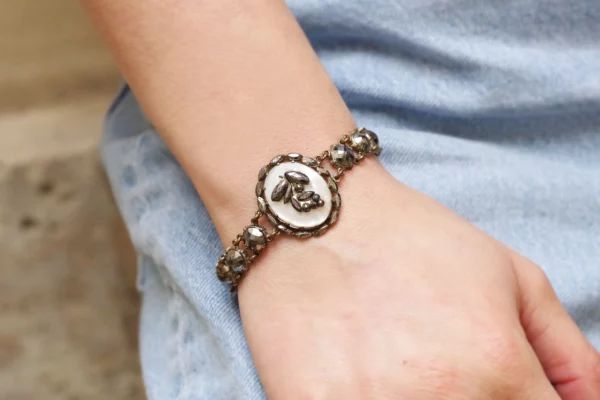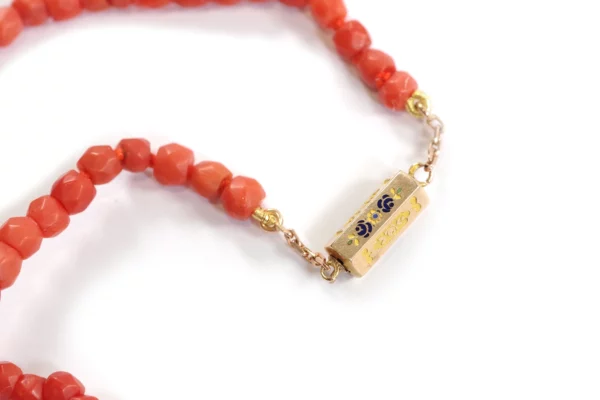323 Products
-

 2000,00€
2000,00€Diamond Art Deco clip brooch in platinum and 18 karat (750) white gold. Triangular-shaped lapel clip, combining the typical lines of Art Deco with the beginning of the curves typical of the Retro period, with scrolls at the top. This lapel clip is set with 51 rose-cut diamonds. Brooch or lapel clip, circa 1930-1940, France.
Dog head hallmark, eagle head hallmark and trace of numbering on reverse, “Déposé” on clasp, Peyret & Cie workshop hallmark (active between 1906 and 1980).
Dimensions: 3.3 cm x 2.7 cm
Estimated diamond weight: 0.30 carat
Condition : scratches from use
Weight : 10.47 gr
*The antique box is not sold with the jewel*
-

 550,00€
550,00€Victorian carnelian watch key pendant in 18 karat (750) rose. An antique watch key pendant, adorned with a large orange cornelian. The structure is rose gold, but the key is metal. Late 19th century jewelry, Victorian period.
Owl hallmark
Dimensions: 57 x 33 mm
Condition: Scratches from use on the metal. The key at the bottom is in metal.
Weight : 11.45 gr
*The antique box and the chain are not sold with the jewel*
See our antique chains -

 1200,00€
1200,00€Antique secret signet ring in 18 karat (750) rose gold. Antique wedding ring monogrammed “FD”. The ring opens under the bezel, revealing a secret compartment that can conceal a sentimental element (a flower, a lock of hair, for example). The inside of the ring is engraved with the words “V. Decondé et F. Destrée unis le 6 juin 1855”, the date of union of the two engaged couples. Antique ring for men. The ring is decorated with rinceaux in relief. Antique secret wedding ring, 1855, France.
Eagle head hallmark (French state hallmark for 18 karat gold), “FD fourmi” goldsmith’s hallmark.
Finger circumference: 65 UE or 11 US (possible resizing)
Bezel size: 8 x 7 mm
Condition: tiny scratches
Weight : 2.68 gr
-

 250,00€
250,00€Antique flower cut steel bracelet with circular faceted steel links. In the center, a studded steel flower is set on a mother-of-pearl plate. Faceted steel has a way of shimmering in the light, giving off a beautiful metallic reflection. The latch-box clasp is concealed behind a link. Early 19th century bracelet, circa 1830.
Total length: 16.8 cm
Design size: 28 mm x 25 mmCondition: some oxidation
Weight : 22.34 gr
Steelpoint jewelry: In the 18th century, the most famous workshop was located in Woodstock, England, near Oxford. The fashion for steel jewelry spread to the end of the 19th century in England and to the beginning of the 20th century in France. The advantage of steel is that, when cut into facets, it can sparkle in the same way as pyrite and imitate the brilliance of a diamond.
Originally accessible to a middle-class clientele, steel jewelry became the prerogative of the nobility as soon as it adopted a particular decoration, becoming increasingly sought-after and expensive.
-

 820,00€
820,00€Coral necklace with French antique clasp in 18 karat (750) rose gold. Choker necklace composed of 92 faceted coral beads. The necklace closes with a barrel clasp with six enameled facets in a floral design. Antique necklace, late 19th century, France.
Eagle head hallmark (French state hallmark for 18 karat gold).
Total length: 37.5 cm
Clasp dimensions: 5 x 11 mmNote: the necklace has been threaded.
Condition: scratches from useWeight : 9.75 gr
-

 750,00€
750,00€Victorian antique compass pendant in 9 karats gold (375). Lovely compass pendant with an arrow turning on the cardinal points to indicate North. It is protected by glass. The compass is decorated all around with a gold chain motif (not flexible). England, Birmingham, 1900.
English hallmarks : Marine anchor (Birmingham), 9, 375, J.T and lower-case letter a (corresponding to the year 1900).
Dimensions: 27 x 19 mm
Diameter: 19 mmCondition: scratches from use
Weight : 4,66 gr
*The antique box and the chain are not sold with the jewel*
See our antique chains -

 900,00€
900,00€Antique coral bracelet and clasp in 18 karat gold (750). Antique bracelet formed of three rows of coral sticks, joined by a delightful clasp decorated with letters. The clasp is a 14 karat (585) rose gold box, marked with letters “AV”. Antique jewelry, circa 1950. Owl hallmark.
Length : 17 cm
Width: 1.5 cmCondition: light usual wears on the gold
Weight : 14.05 gr
-

 210,00€
210,00€Small enameled clasp pendant in 18 karat (750) gold. This Normandy clasp, in hollow gold. It is decorated with colored enamel: on one side, a red enameled flower framed by midnight-blue leaves, within a cartouche. The cartouche is surrounded by a jagged frieze; on the other side, the same motif […]
-

 3700,00€
3700,00€Russian turquoise drapery necklace in 14 karat (583) rose gold. Drapery necklace composed of eleven drop-shaped turquoise plaques on matrix (visible on back), topped with round cabochons. The necklace is finished with a double chain of flat links. The turquoise may have come from Kazakhstan, a country under Russian rule since the 17th century, where turquoise mines are still found, but more likely from Persia, which supplied countries and courts with its beautiful, intense-blue stones. Turquoise from Kazakhstan is generally blue with a hint of lavender inside, suggesting Persian turquoise. Necklace circa 1900, chain changed afterwards.
Shell hallmark, on the chain, certainly changed after the necklace was made: Russian “sickle and hammer” hallmark (active after 1958), SAS or GAS hallmark on the clasp.
Total length: 42 cm
Dimensions of largest drop: 21 x 45 mmNote: The slight difference in gold color between the chain and the necklace suggests a modification of the jewel.
Condition : wears of useWeight : 35.20 gr
About turquoise: Read our article by clicking here.
-

 600,00€
600,00€Edwardian diamond pearl arrow brooch in 18 karats rose gold and silver. Brooch featuring an arrow with 22 diamonds on the tip and tail, and a fine pearl on the shaft (diameter approx. 4.9 mm). Antique brooch, late 19th – early 20th century.
Partially inscribed owl hallmark (French State hallmark for 18 karat gold).
Dimensions: 10 x 52 mm
Estimated total diamond weight: 0.11 caratCondition: light scratches and oxidation
Weight : 3.75 gr
-

 300,00€
300,00€Vintage paste costume bracelet in gold-plated metal. Vintage costume bracelet set with white rhinestones and cabochon glass imitating opals. Vintage bracelet, circa 1950. “Fake jewelry” was very fashionable at the time, as precious metals had been requisitioned for the war effort. Cost-effective adornment with rhinestones and gilded metal.
Total length: 16.5 cm
Weight : 33.11 gr
More information : “Fake jewelry” was very fashionable at the time, as precious metals had been requisitioned for the war effort. Cost-effective adornment with rhinestones and gilded metal.
-

 750,00€
750,00€Victorian compass pendant in 9 karat gold (375). A very original compass-shaped pendant that can be rotated on itself, allowing it to be placed on the table to find North. Inside, an arrow rotates on the cardinal points. The compass is two-sided, with both sides protected by glass. It is decorated with a gold cord that holds the hoop. The North indication works. Made in England, Birmingham, 1891.
Clover hallmark, Marks: Marine anchor (Birmingham), R for 1891, MW.
Dimensions: 32 x 20 mm
Diameter: 20 mmCondition: dust inside the compass, slight dents, wear light scratches on gold and glass.
Weight: 5.26 gr
*The antique box is not sold with the jewel*
Learn more: How does a compass work? A moving needle inside the compass reacts to a magnet, the Earth. Indeed, as our planet contains a lot of iron, it is magnetic, and the small moving needle inside the compass uses this to indicate the north-south direction. However, this only works if there are no other magnets near the compass. Note that the needle of a magnetic steel compass always points approximately north.
